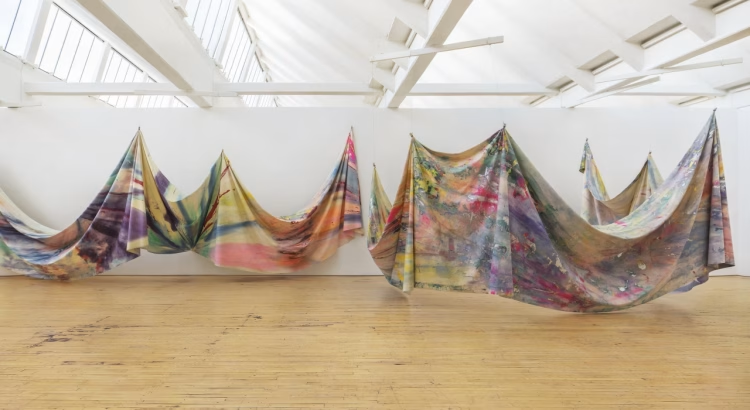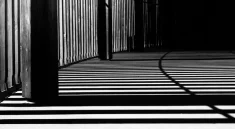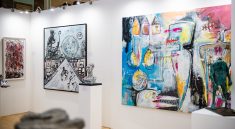Robert Draws – Sam Gilliam’s Fabric Revolution is a transformative moment in the dialogue between abstract art and physical space. Known for his radical departure from the traditional stretched canvas, Gilliam’s latest showcase at the Irish Museum of Modern Art brings forth an evolution of his signature style. The exhibition, titled Sewing Fields, invites viewers into a realm where color, fabric, and form exist in harmony without restriction.
Through sewn, draped, and suspended cloth, Gilliam dissolves the boundary between painting and sculpture. His works, once confined to walls, now move into open space, dancing freely under light and shadow. In a time when contemporary art increasingly seeks to blur genres and disciplines, Gilliam’s creations offer a poetic yet powerful statement about liberation and innovation. Visitors are not simply viewers but participants, walking among works that defy rigid frames. Sewing Fields reminds us that abstraction can speak, move, and breathe beyond its inherited limits.
A Pioneer of the Washington Color School
Sam Gilliam emerged during the 1960s as a vital voice in American abstract painting. As a key figure of the Washington Color School, he explored color-field techniques while bringing a distinct sensibility shaped by his personal and cultural background. Unlike many of his contemporaries, Gilliam did not confine color to flat surfaces. Instead, he experimented with staining and draping techniques that would later define his legacy. At a time when minimalism dominated many art circles, Gilliam’s vibrant and emotionally charged use of color challenged the status quo. His commitment to pushing abstraction into the third dimension not only influenced American art but inspired younger generations globally. In many retrospectives, Gilliam’s work has been credited with expanding the definition of painting itself. His approach allowed color to break free from geometric constraints and flow with rhythm. Today, his contributions continue to be celebrated as foundational within modern visual culture.
“Read about: To Look with Love: Jess T. Dugan’s Radical Portraits of Identity and Belonging”
Sewing Fields: Painting Becomes Sculpture
The Sewing Fields exhibition marks a new chapter in Gilliam’s exploration of form. Here, painted fabrics are not just visual statements but tactile interventions. Rather than being displayed in frames or under glass, the works are suspended, folded, or even partially stitched together to form immersive installations. Some pieces hang like banners, while others twist into sculptural expressions that echo movement. These installations suggest fields of memory, resistance, and celebration. The fabric, once painted in vibrant acrylic washes, carries the energy of abstract expressionism into a new spatial dimension. The stitching is not only functional but expressive, suggesting care, effort, and the human hand at work. Although fabric has long been seen as domestic or decorative, Gilliam transforms it into a medium of conceptual strength. The result is a space filled with color that feels alive. Each thread, each curve of fabric, offers something deeply personal yet universally resonant.
Legacy and Influence Across Borders
Gilliam’s artistic evolution speaks to a larger narrative of global influence and transdisciplinary experimentation. His works have been featured in major institutions across the United States, and now Europe engages with his vision through exhibitions like Sewing Fields. The decision to show these works in Ireland underlines the international significance of his practice.
It is not just the beauty of the fabric or the scale of his installations that impress viewers, but also the conceptual rigor behind them. Young artists today draw inspiration from his refusal to follow fixed rules. Gilliam showed that painting could be liberated from the frame, and his legacy continues in contemporary installation, fiber art, and performance. His ability to merge visual intensity with political subtext has earned him respect in academic and curatorial spaces. In Dublin, audiences now have the opportunity to walk through these textile landscapes and reflect on an artist who reshaped modern abstraction.
“Read more: United Against Trafficking: African Union Endorses Continental Guidelines”
Materiality and Meaning in Gilliam’s Work
The choice of fabric in Sam Gilliam’s recent work is more than aesthetic. Materiality itself becomes a language through which ideas of identity, memory, and transformation are communicated. Cloth is both intimate and universal. It wraps the body, carries history, and has long served as a vessel for cultural storytelling. Gilliam’s fabrics, painted in layers of vibrant hues, absorb and reflect light in unpredictable ways. The works resist perfection.
They fold and crease, shift with air currents, and bear the marks of process. Through these choices, Gilliam affirms that art can be as dynamic as the life it reflects. The lack of hard edges in his works encourages interpretation over judgment. Audiences must move around and within the installations to fully appreciate their complexity. In doing so, they become part of the piece. This act of inclusion is a powerful reminder that meaning in art is not fixed but made through engagement.



